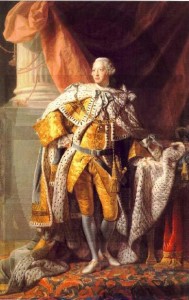George III ruled Britain for fifty nine years. He was dubbed “Farmer George” by satirists. American Revolutionaries called him a tyrant although history will show he was a man of the people. George William Frederick was born the 4th of June 1738 and died January 29th, 1820.
Upon his eighteenth birthday his grandfather George II offered him St. James Palace but guided by his mother and her confident Lord Bute he remained at home where his mother continued to influence him to adopt a rigid moral standard. In 1759 George fell in love with Lady Sarah Lennox, sister of the Duke of Richmond but once again with Lord Bute’s insistence George abandoned marriage plans. In 1760 George II died suddenly and George ascended to the throne.
The early years of George’s reign were marked by political instability. Much of this stemmed from political disagreement over the prosecution of the Seven Years War. In May of 1762 the Whigs lost control of Parliament and the Scottish Tory Lord Bute became Prime Minister.
Almost immediately Bute’s enemies began to discredit him by spreading rumors that he was having an affair with the King’s Mother. John Wilkes a member of Parliament published the now infamous paper North Britian that exploited anti Scottish sentiment. Wilkes was charged with seditious liable for his political attacks on Lord Bute and the King.
In 1763 King George issued the Royal Proclamation that sought to create a boundary line between the colonists and the Native American population. The intent was to reduce the costs of fighting frontier battles with the Indians in America. This same year when the Treaty of Paris was concluded ending the French and Indian War, Lord Bute was forced to resign as a consequence of the scandals surrounding him. George Grenville became the new Prime Minister.
Grenville very quickly exacerbated Britain’s relationship with her American colonies when he past the Stamp Act in 1765 to raise revenue to reduce the deficit caused by defending the colonies during the French and Indian War. Grenville could have chosen Ben Franklin’s land bank and national currency plan whereby the British would run the land bank and collect interest payments rather than raise taxes, however; Grenville chose to pass the Stamp Act instead. The King became exasperated with Grenville over the Stamp Act and tried to encourage William Pitt the Elder to become Prime Minister. Pitt refused and King George settled for Lord Rockingham who repealed the hated Stamp Act.
It was Lord North’s government that through a series of decisions intended to assuage American opinion which triggered the American Revolution. First, Lord North began by passing the Tea Act of 1773 that actually reduced the price of East India Tea to a price below that of John Hancock’s smuggled Dutch tea. Hancock and Samuel Adams created the Boston Tea Party and taxation without representation as a response to the Tea Act. Lord North determined that the destruction of the tea in Boston Harbor was a criminal act and passed legislation known in the colonies as the Intolerable Acts which General Thomas Gage lobbied Parliament to pass. This series of acts essentially closed the port of Boston.
Up to this point the King had hoped for a peaceful political solution despite his skepticism of Parliament’s plans for the colonies. His behavior was far less ruthless than other monarchs of his time. Recent research has indicated that King George was essentially blameless in causing the American Revolution.
In 1778 France signed a Treaty of Friendship with the American colonies which placed England back in a state of war with France. As the war continued its rising costs led to increased opposition. In 1781 Lord Cornwallis surrendered at the siege of York Town. This effectively ended the American Revolution although no formal treaty was signed until the Treaty of Paris in 1783.
Not long after the end of the American Revolution King George’s health began to deteriorate. He suffered from mental illness which today has been defined as a blood disease known as porphyria.
The French Revolution and the rise and fall of Napoleon Bonaparte also occurred during George’s reign. In 1800 the British and Irish Parliaments signed the Act of Union to create the United Kingdom.
By the end of 1811 King George had become insane and was replaced by his son George as Royal Regent for the rest of his life. When George III died he was succeeded by his son George IV.
Sources:
The Ideological Origins of the American Revolution. Bailyn, Bernard. The Belknap Press of Harvard University. Cambridge Mass. 1990
The Radicalism of the American Revolution. Wood, Gordon S. Alfred A. Knopf. New York, NY. 1992
The Works of Edmund Burke Volumes I-II. Burke, Edmund. Little, Brown and Company Boston, Mass. 1865
George III of the United Kingdom – Wikipedia the free encyclopedia http://en.wikipedia.org/wiki/George_III_of_the_United_Kingdom
